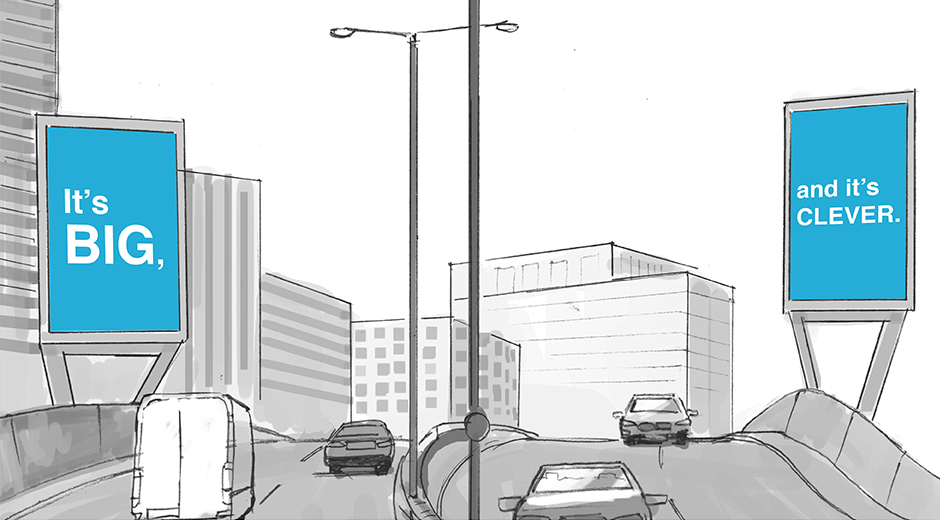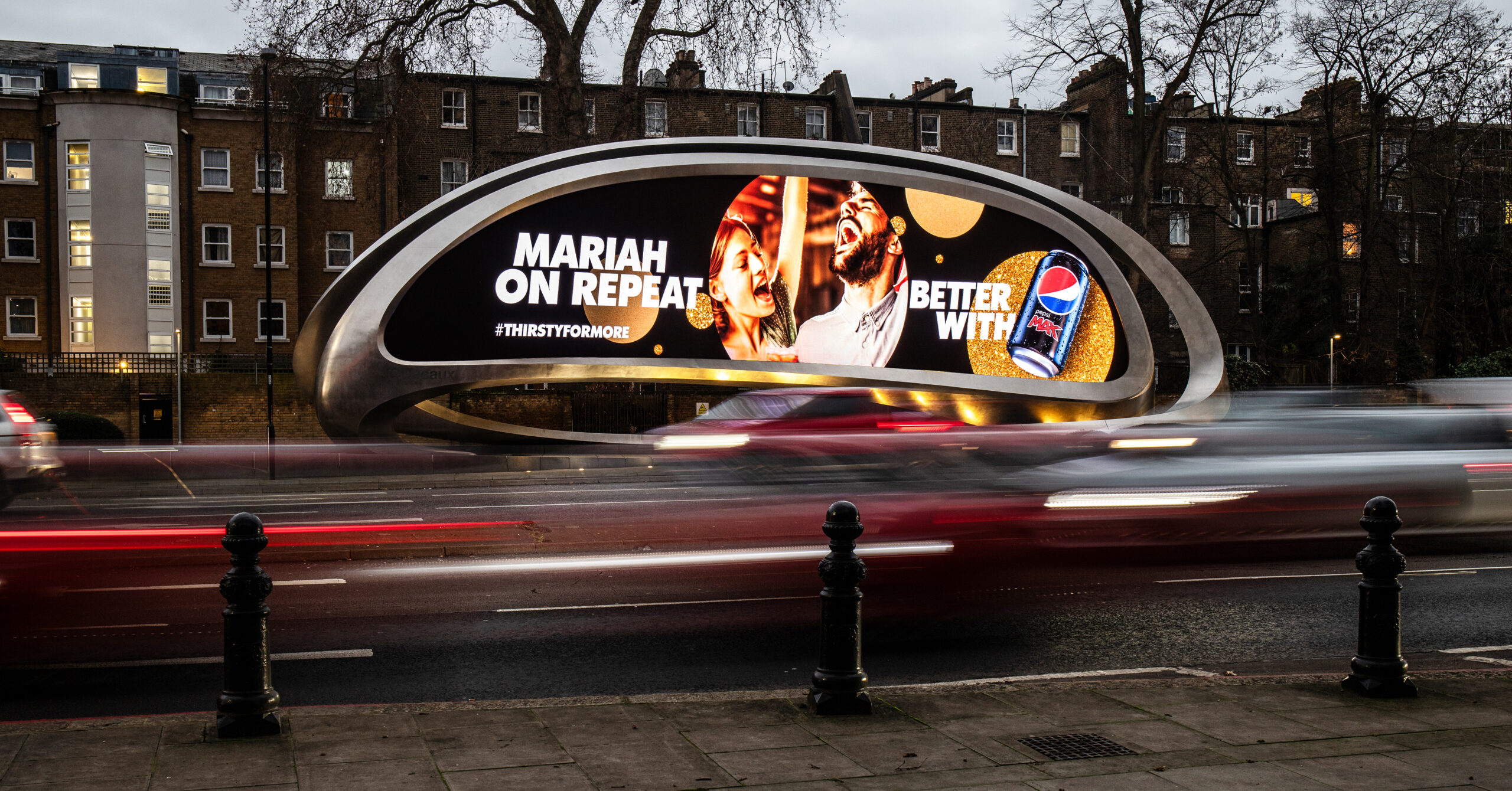It’s Big and It’s Clever: DOOH Is Delivering Engagement at Scale
By Neil Morris, Founder, Grand Visual
DOOH is delivering intelligent advertising at real scale every day and great progress has taken place over the past 10 years, the same 10 years that Grand Visual has been getting busy. We’re extremely proud of the work we’ve done over that time to break new ground and pioneer the use of creative technology and of execution technique.
So in the spirit of our 10th birthday I’ve pulled together 10 observations about the current state of the industry which I’ve been sharing at various events.
1: THREE REGULAR TYPES OF DOOH HAVE EMERGED
An informal categorisation of campaigns has emerged and there are 3 types:
Linear display – usually animation or live action video or static “spot” played in a loop
Dynamic display – messaging that is feed based or triggered by specific events or updates
Interactive – touchscreen or AR or mobile driven interaction between user and creative
Across the industry these are accepted categories and even if the exact description or terminology varies there is a way to quickly establish what the campaign profile is.
Of course, each type will have different elements and associated potential issues. Linear is relatively simple whilst dynamic will require longer lead times and more testing and QA. Interactive may involve additional hardware and experiential elements.
2: INFRASTRUCTURE VS PEOPLE
We are all clear on the sheer scale of investment that has been put into site development and hardware by media owners but I wonder if that investment has been at the cost of the human infrastructure required to make the most of it.
The skillset and mindset required for digital OOH is different to that of traditional OOH. Either through retraining or new hires the industry needs more “digital” people in order to facilitate the growing ambition for the channel.
3: SCALABLE (GLOBAL) CAMPAIGNS
Other territories are catching up with the UK.
The proliferation of digital inventory across the US, Europe, Australia and the Middle and Far East means that global DOOH campaigns are possible, practical and make sense in terms of leveraging campaign execution budget.
This is a real plus for DOOH as a channel and it’s chances of attracting media budget.
4: SMARTER CREATIVE
Smarter and more dynamic creative should be the norm by now. Tactical and smart creative using data to contextualise messaging and target audiences is not “innovation” and should not go in the “innovation” box.
Posterscope’s excellent recent study into dynamic usage tells us that:
- 87% of UK marketing leaders believe real-time DOOH would enable more targeted advertising for their brands.
- But less than 5% of DOOH spend incorporates an element of real-time in DOOH.
So there is huge “head room” for growing the level of dynamic activity to reach client ambition. To do that we must challenge every brief response with smart digital enhancement and make, dynamic campaigns “everyday” not “special”.
5: CREATIVE AGENCIES ARE KEY INFLUENCERS
Despite creative agencies being key influencers there are some examples of an agency not being as supportive of smarter digital OOH as they, or we, would want.
Successful delivery of “smarter” DOOH really comes down to workflow. The increased effort smarter campaigns require can be difficult for a creative agency to deliver against. Timelines can be short and pressured and these factors must be better communicated. At the same time we must all work together to make using digital OOH easier to engage with.
6: REPORTING IS INEVITABLE
If we want a truly digital medium – one that can offer flexibility, intelligence, speed and relevance – we must embrace a campaign flow that is complex to manage and maintain. Smart campaigns inevitably bring an abundance of permutations from scheduling through to triggers and outcomes.
Stakeholders must have visibility of all of these moving parts as a campaign runs. Monitoring and reporting are key to ensuring a campaign runs correctly, to adjusting a campaign’s profile, to measuring effectiveness against other data sources.
So if we want this truly digital medium, visibility and reporting must come as part and parcel of it.
7: PROPERLY INTEGRATED CAMPAIGNS
As DOOH becomes more “digital” it becomes more agile, it becomes more able to add value to other channels, it becomes richer and it is more able to play its part in a big idea that is carried across multiple channels.
We see it more and more that DOOH can be more than support – it can be an active element in a multi-layered campaign and this is where DOOH’s future lies.
8: ONE TEAM ONE DREAM
Campaigns often require constant updates meaning frequent interface between agency, production and media owner. This is a multi-stakeholder project profile and it fails if we do not work together. Collaboration and cooperation go a long way towards effective campaign delivery.
Out-dated, black and white assumptions of partner roles are counter-productive. One team, one dream people.
9: FEED THE HUNGRY BEAST
We can be happy with the scale and intelligence of DOOH and it’s ability to deliver on audience engagement. But there is a major challenge from the OOH audience in the shape of expectation levels.
People believe and presume that digital media can easily be rich and real-time and entertaining. That means we have to match that with the quality of DOOH campaign work.
We must not disappoint our audience.
10: THE FUTURE OF THE MEDIUM IS IN SAFE HANDS
All areas of the industry (from creative, to planning, to execution and display) are now populated by people who have grown up with DOOH and don’t consider it “new and emerging”.
There are, of course, still people who will stand in the way of progress but sometimes you can’t persuade a dinosaur to get out of your way – you have to wait for it to die.
IN CONCLUSION
So, following an amazing 10 years, where do we go from here?
- We must lose the “emerging media” badge – it’s an excuse to be sub-optimal.
- We must not rest on our laurels or be resistant to further change.
- We must be proactive in terms of process, systems, infrastructure and talent.
Albert Einstein said:
“Life is like riding a bike. To keep your balance you must keep moving.”
And that is definitely true for DOOH. To not fall over in a constantly evolving digital media ecosystem we must be active and keep moving.




